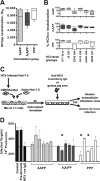Combined adenovirus vector and hepatitis C virus envelope protein prime-boost regimen elicits T cell and neutralizing antibody immune responses
- PMID: 24599994
- PMCID: PMC4019094
- DOI: 10.1128/JVI.03574-13
Combined adenovirus vector and hepatitis C virus envelope protein prime-boost regimen elicits T cell and neutralizing antibody immune responses
Abstract
Despite the recent progress in the development of new antiviral agents, hepatitis C virus (HCV) infection remains a major global health problem, and there is a need for a preventive vaccine. We previously reported that adenoviral vectors expressing HCV nonstructural proteins elicit protective T cell responses in chimpanzees and were immunogenic in healthy volunteers. Furthermore, recombinant HCV E1E2 protein formulated with adjuvant MF59 induced protective antibody responses in chimpanzees and was immunogenic in humans. To develop an HCV vaccine capable of inducing both T cell and antibody responses, we constructed adenoviral vectors expressing full-length and truncated E1E2 envelope glycoproteins from HCV genotype 1b. Heterologous prime-boost immunization regimens with adenovirus and recombinant E1E2 glycoprotein (genotype 1a) plus MF59 were evaluated in mice and guinea pigs. Adenovirus prime and protein boost induced broad HCV-specific CD8+ and CD4+ T cell responses and functional Th1-type IgG responses. Immune sera neutralized luciferase reporter pseudoparticles expressing HCV envelope glycoproteins (HCVpp) and a diverse panel of recombinant cell culture-derived HCV (HCVcc) strains and limited cell-to-cell HCV transmission. This study demonstrated that combining adenovirus vector with protein antigen can induce strong antibody and T cell responses that surpass immune responses achieved by either vaccine alone.
Importance: HCV infection is a major health problem. Despite the availability of new directly acting antiviral agents for treating chronic infection, an affordable preventive vaccine provides the best long-term goal for controlling the global epidemic. This report describes a new anti-HCV vaccine targeting the envelope viral proteins based on adenovirus vector and protein in adjuvant. Rodents primed with the adenovirus vaccine and boosted with the adjuvanted protein developed cross-neutralizing antibodies and potent T cell responses that surpassed immune responses achieved with either vaccine component alone. If combined with the adenovirus vaccine targeting the HCV NS antigens now under clinical testing, this new vaccine might lead to a stronger and broader immune response and to a more effective vaccine to prevent HCV infection. Importantly, the described approach represents a valuable strategy for other infectious diseases in which both T and B cell responses are essential for protection.
Figures




Similar articles
-
Recombinant hepatitis C virus envelope glycoprotein vaccine elicits antibodies targeting multiple epitopes on the envelope glycoproteins associated with broad cross-neutralization.J Virol. 2014 Dec;88(24):14278-88. doi: 10.1128/JVI.01911-14. Epub 2014 Oct 1. J Virol. 2014. PMID: 25275133 Free PMC article.
-
Induction of broad CD4+ and CD8+ T-cell responses and cross-neutralizing antibodies against hepatitis C virus by vaccination with Th1-adjuvanted polypeptides followed by defective alphaviral particles expressing envelope glycoproteins gpE1 and gpE2 and nonstructural proteins 3, 4, and 5.J Virol. 2008 Aug;82(15):7492-503. doi: 10.1128/JVI.02743-07. Epub 2008 May 28. J Virol. 2008. PMID: 18508900 Free PMC article.
-
Superior immunogenicity of HCV envelope glycoproteins when adjuvanted with cyclic-di-AMP, a STING activator or archaeosomes.Vaccine. 2017 Dec 15;35(50):6949-6956. doi: 10.1016/j.vaccine.2017.10.072. Epub 2017 Oct 28. Vaccine. 2017. PMID: 29089195
-
Development and evidence for efficacy of CMV glycoprotein B vaccine with MF59 adjuvant.J Clin Virol. 2009 Dec;46 Suppl 4(Suppl 4):S73-6. doi: 10.1016/j.jcv.2009.07.002. Epub 2009 Jul 31. J Clin Virol. 2009. PMID: 19647480 Free PMC article. Review.
-
Approaches, Progress, and Challenges to Hepatitis C Vaccine Development.Gastroenterology. 2019 Jan;156(2):418-430. doi: 10.1053/j.gastro.2018.08.060. Epub 2018 Sep 27. Gastroenterology. 2019. PMID: 30268785 Free PMC article. Review.
Cited by
-
Hepatitis C Virus Infection and Vaccine Development.J Clin Exp Hepatol. 2018 Jun;8(2):195-204. doi: 10.1016/j.jceh.2018.02.003. Epub 2018 Feb 16. J Clin Exp Hepatol. 2018. PMID: 29892184 Free PMC article. Review.
-
Immunization With a Subunit Hepatitis C Virus Vaccine Elicits Pan-Genotypic Neutralizing Antibodies and Intrahepatic T-Cell Responses in Nonhuman Primates.J Infect Dis. 2017 Jun 15;215(12):1824-1831. doi: 10.1093/infdis/jix180. J Infect Dis. 2017. PMID: 28398489 Free PMC article.
-
Recombinant Flag-tagged E1E2 glycoproteins from three hepatitis C virus genotypes are biologically functional and elicit cross-reactive neutralizing antibodies in mice.Virology. 2018 Jun;519:33-41. doi: 10.1016/j.virol.2018.03.026. Epub 2018 Apr 6. Virology. 2018. PMID: 29631174 Free PMC article.
-
Safety and Immunogenicity of a rAd35-EnvA Prototype HIV-1 Vaccine in Combination with rAd5-EnvA in Healthy Adults (VRC 012).PLoS One. 2016 Nov 15;11(11):e0166393. doi: 10.1371/journal.pone.0166393. eCollection 2016. PLoS One. 2016. PMID: 27846256 Free PMC article. Clinical Trial.
-
BacMam virus-based surface display for HCV E2 glycoprotein induces strong cross-neutralizing antibodies and cellular immune responses in vaccinated mice.Infect Agent Cancer. 2021 Dec 18;16(1):69. doi: 10.1186/s13027-021-00407-x. Infect Agent Cancer. 2021. PMID: 34922563 Free PMC article.
References
Publication types
MeSH terms
Substances
Grants and funding
LinkOut - more resources
Full Text Sources
Other Literature Sources
Research Materials
Miscellaneous

